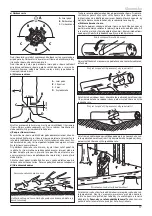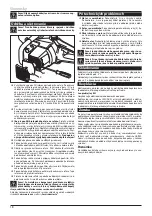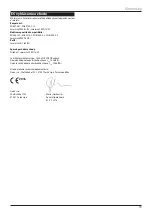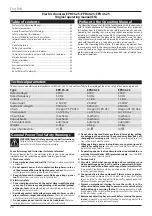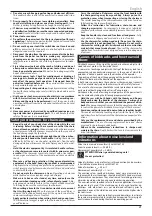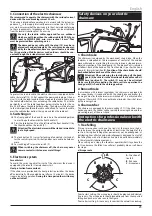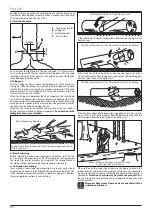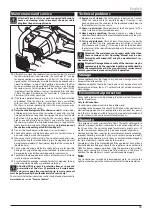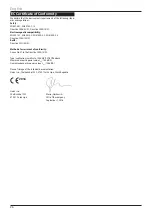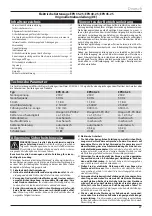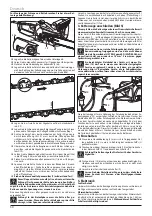
English
24
position of larger branches and wind direction so that the direction of
tree fall may be established. Impurities, stones, free bark, bolts and wires
have to be removed from the tree at first.
b) Creation of a notch
A
D
B
C
~50 mm
~50 mm
A
- Direction of tree fall
B
- Felling cut
C
- Notch (undercut)
D
- Trunk residue
Cut a notch at the right angle to the tree as deep as 1/3 of tree diame-
ter. To make the notch, the horizontal cut shall be done at first to avoid
jamming (seizing) of the chainsaw or the guide bar when starting the
second oblique cut of the notch.
c) Felling cut
Start the felling cut 50 mm above the horizontal cut of the notch, see
the Figure. Make the felling cut in parallel with the notch and so deep
that the trunk residue may remain preserved as a “suspension”. The trunk
residue prevents tree swivelling and its fall in the incorrect direction.
Do not cross-cut the tree residue.
When the felling cut approaches the notch (undercut), the tree should
start to fall. If it appears that the tree will most probably not fall in the
desired direction or will be leaned back and will close the chainsaw, stop
cutting and use wooden, plastic or aluminium wedges for opening the
felling cut and for correct directing the tree.
When the tree starts to fall, take the chainsaw out of the cut, switch it
off and leave the risk zone using the escape route.
Pay attention to the
falling branches not to stumble!
Keep distance from the ground. Leave the supporting branches un-
til the trunk is cut
Branch trimming direction
d) Branch trimming
Branch trimming is understood separation of branches from the fall-
en tree. When trimming, leave at first the larger branches supporting
the trunk. Trim smaller branches by a single cut. The sprung branches
should be cut from bottom to top to avoid chainsaw jamming.
e) Tree trunk cross-cutting
Cross-cutting is understood trunk separation into shorter parts. Do not
forget to be steady and to distribute body weight onto both legs. The
trunk should be supported by branches, beams or wedges, if possible.
Observe simple instructions for easy cutting.
Cut from the top! Do not touch the ground!
If the whole trunk length is supported uniformly, see the Figure, cut
from the top.
2.
1.
The first cut from below (1/3 of the diameter) to avoid splitting
If the trunk lies on the ground by its one end, see Figure, cut at first
1/3 of trunk diameter from the bottom side and then the remaining part
from the top as deep as the bottom cut.
2.
1.
The first cut from below (1/3 of the diameter) to avoid splitting
If the trunk lies above a field depression supported on its ends, see Fig-
ure, cut at first 1/3 of trunk diameter from the bottom side and then the
remaining part from the top as deep as the bottom cut.
When cutting on the slope, always be steady
on your legs above the trunk!
When cutting on the slope, stay as shown in the Figure. To have a full
control over the chainsaw at the moment of full cross-cut, reduce the
pressure in the final cut phase, still holding chainsaw handles firmly in
your hands.
Attention, the chain may not touch the ground!
When
the cut is complete, wait until the chain is stopped and only then take
out the chainsaw.
Attention! Never move from one tree to another with the
switched on chainsaw.
Summary of Contents for EPR 35 -25
Page 4: ...4 12 11 9 3 2 4 5 6 13 14 15 9 18a 18b 10 16 8 7 17 16 19 20 17 23 22 21 1 14 18 ...
Page 62: ...62 ...
Page 63: ...63 ...








